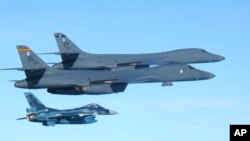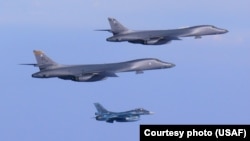The U.S. Air Force flew two B-1B bombers over the Korean Peninsula Saturday, accompanied by South Korean and Japanese jet fighters.
The U.S. Pacific Command said the mission was in “direct response” to North Korea’s “escalatory launch” of intercontinental ballistic missiles July 3 and July 28.
“North Korea remains the most urgent threat to regional stability,” said General Terrence O’Shaughnessy, U.S. Pacific Air Forces commander. “Diplomacy remains the lead; however, we have a responsibility to our allies and our nation to showcase our unwavering commitment while planning for the worse-case scenario. If called upon, we are ready to respond with rapid, lethal and overwhelming force at a time and place of our choosing.”
The 10-hour joint forces mission began at Andersen Air Force Base in Guam. U.S. Air Force bomber jets were joined by two Japanese F-2 fighter jets in Japanese airspace. The U.S. bombers then flew over the Korean Peninsula and were accompanied by four South Korea fighter jets. The U.S. bombers also did a low-pass over South Korea’s Osan Air Base, before returning to Guam.
Trump criticizes China
Also Saturday, U.S. President Donald Trump again criticized China for failing to stop North Korea’s ballistic missile and nuclear weapons programs.
Following Friday's launch of an intercontinental ballistic missile that landed west of Japan, the U.S. president singled out China for blame on Saturday evening, saying the country could "easily solve this problem."
Trump's remarks echoed those made by Secretary of State Rex Tillerson, who released a statement that blamed both China and Russia for North Korea's continued violations of U.N. Security Council resolutions.
"As the principal economic enablers of North Korea's nuclear weapon and ballistic missile development program, China and Russia bear unique and special responsibility for this growing threat to regional and global stability," Tillerson said.
In April, Trump praised his first meeting with China's President Xi Jinping, later telling reporters that Xi had agreed to suspend coal and fuel shipments to pressure North Korea to stop its belligerent behavior. However, since then, the North has continued to threaten its neighbors and the United States, and Trump has grown more critical of Beijing.
North Korea's missile launch Friday was its second this month. Even though the missile landed west of Japan, experts said it would be powerful enough to reach much of the U.S. mainland. North Korea's official news agency said leader Kim Jong Un boasted that the latest test was "meant to send a grave warning to the U.S."
China condemned the launch, while Japan, South Korea and the U.S. vowed to work together on a new Security Council measure aimed at curbing North Korea's nuclear ambitions.
Word of Friday's missile launch came as a bill approved by Congress calling for tougher sanctions on North Korea, as well as Iran and Russia, landed on Trump's desk.












